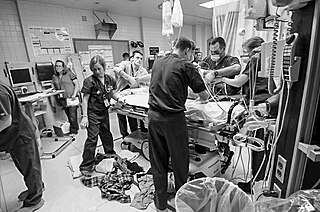
Emergency medicine is the medical speciality concerned with the care of illnesses or injuries requiring immediate medical attention. Emergency physicians continuously learn to care for unscheduled and undifferentiated patients of all ages. As first-line providers, in coordination with emergency medical services, they are primarily responsible for initiating resuscitation and stabilization and performing the initial investigations and interventions necessary to diagnose and treat illnesses or injuries in the acute phase. Emergency physicians generally practise in hospital emergency departments, pre-hospital settings via emergency medical services, and intensive care units. Still, they may also work in primary care settings such as urgent care clinics.

Auckland University of Technology is a university in New Zealand, formed on 1 January 2000 when a former technical college was granted university status. AUT is New Zealand's third largest university in terms of total student enrolment, with approximately 29,100 students enrolled across three campuses in Auckland. It has five faculties, and an additional three specialist locations: AUT Millennium, Warkworth Radio Astronomical Observatory and AUT Centre for Refugee Education.
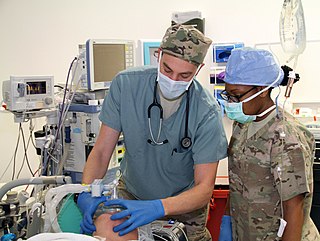
Anesthesiology, anaesthesiology, or anaesthesia is the medical specialty concerned with the total perioperative care of patients before, during and after surgery. It encompasses anesthesia, intensive care medicine, critical emergency medicine, and pain medicine. A physician specialized in anesthesiology is called an anesthesiologist, anaesthesiologist, or anaesthetist, depending on the country. In some countries, the terms are synonymous, while in other countries they refer to different positions, and anesthetist is only used for non-physicians, such as nurse anesthetists.

The Journal of the American Medical Association (JAMA) is a peer-reviewed medical journal published 48 times a year by the American Medical Association. It publishes original research, reviews, and editorials covering all aspects of biomedicine. The journal was established in 1883 with Nathan Smith Davis as the founding editor. Kirsten Bibbins-Domingo of the University of California San Francisco became the journal editor-in-chief on July 1, 2022, succeeding Howard Bauchner of Boston University.
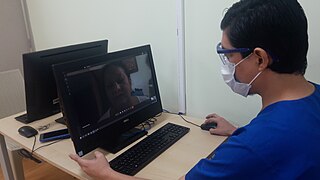
Telehealth is the distribution of health-related services and information via electronic information and telecommunication technologies. It allows long-distance patient and clinician contact, care, advice, reminders, education, intervention, monitoring, and remote admissions. Telemedicine is sometimes used as a synonym, or is used in a more limited sense to describe remote clinical services, such as diagnosis and monitoring. When rural settings, lack of transport, a lack of mobility, conditions due to outbreaks, epidemics or pandemics, decreased funding, or a lack of staff restrict access to care, telehealth may bridge the gap as well as provide distance-learning; meetings, supervision, and presentations between practitioners; online information and health data management and healthcare system integration. Telehealth could include two clinicians discussing a case over video conference; a robotic surgery occurring through remote access; physical therapy done via digital monitoring instruments, live feed and application combinations; tests being forwarded between facilities for interpretation by a higher specialist; home monitoring through continuous sending of patient health data; client to practitioner online conference; or even videophone interpretation during a consult.
eHealth is a relatively recent healthcare practice supported by electronic processes and communication, dating back to at least 1999. Usage of the term varies as it covers not just "Internet medicine" as it was conceived during that time, but also "virtually everything related to computers and medicine". A study in 2005 found 51 unique definitions. Some argue that it is interchangeable with health informatics with a broad definition covering electronic/digital processes in health while others use it in the narrower sense of healthcare practice using the Internet. It can also include health applications and links on mobile phones, referred to as mHealth or m-Health.
The ICMJE recommendations are a set of guidelines produced by the International Committee of Medical Journal Editors for standardising the ethics, preparation and formatting of manuscripts submitted to biomedical journals for publication. Compliance with the ICMJE recommendations is required by most leading biomedical journals. Levels of real compliance are subject to debate. As of 9 January 2020, 5570 journals worldwide claim to follow the ICMJE recommendations.

An intensive care unit (ICU), also known as an intensive therapy unit or intensive treatment unit (ITU) or critical care unit (CCU), is a special department of a hospital or health care facility that provides intensive care medicine.
UpToDate, Inc. is a company in the Wolters Kluwer Health division of Wolters Kluwer whose main product is UpToDate, a software system that is a point-of-care medical resource.

Middlemore Hospital is a major public hospital in the suburb of Otahuhu, Auckland, New Zealand. The hospital has approximately 800 beds. There are 24 operating theatres across two sites.
Emergency medical services in New Zealand are provided by the Order of St John, except in the Greater Wellington region where Wellington Free Ambulance provides these services. Both have a history of long service to their communities, St John since 1885 and Free beginning in 1927, traditionally having a volunteer base, however the vast majority of response work is undertaken by paid career Paramedics. Strategic leadership of the sector is provided by NASO which is a unit within the Ministry of Health responsible for coordinating the purchasing and funding of services on behalf of the Ministry and the Accident Compensation Corporation.
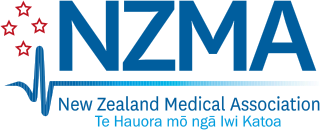
The New Zealand Medical Association (NZMA) is an association representing some doctors and medical students in New Zealand. It was officially founded after a meeting in April 1886 at Dunedin Hospital. From 1896 to 1967, the NZMA was considered as a branch of the British Medical Association and was known as the New Zealand Branch of the British Medical Association well into the 1970s. In the 1960s, Erich Geiringer, who was in conflict with the association, exploited the potential for confusion by founding the New Zealand Medical Association. Geiringer's NZMA included a number of progressive physicians and was very involved in political debates.
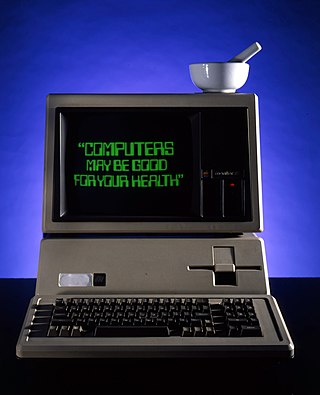
Health information on the Internet refers to all health-related information communicated through or available on the Internet.
Allison Margaret Kirkman is a New Zealand sociology academic with interests in 'death and dying; gender, sexuality, ageing and health; health care work and workers.' In 2014 she was appointed the Vice Provost at Victoria University of Wellington before moving to become Pro-Vice Chancellor for the Division of Arts, Law, Psychology and Social Sciences at the University of Waikato. She was made an Emeritus Professor at the University of Waikato in 2022 in recognition of her work to set up a nursing programme at the university.
Smoking in Tokelau is prevalent, with ethnic Tokelauans having the highest smoking prevalence of all Pacific ethnicities. In the 2011 Tokelau Census, 47.8% of people aged over 15 were found to be regular cigarette smokers.
Matire Louise Ngarongoa Harwood is a New Zealand clinical researcher and trainee general practitioner.She is an associate professor at the University of Auckland. Harwood was the 2017 New Zealand L'Oréal UNESCO For Women in Science Fellow. Her expertise is in Māori health, focussed on reducing health inequity by improving indigenous health and well-being.
The Medication Appropriateness Tool for Comorbid Health conditions during Dementia (MATCH-D) criteria supports clinicians to manage medication use specifically for people with dementia without focusing only on the management of the dementia itself.
Nicola Mary Turner is a New Zealand public health advocate who is an honorary Professor at the University of Auckland and Director of the Immunisation Advisory Centre, an organisation that advises the New Zealand medical profession and the New Zealand Government. She has contributed to advisory committees for the New Zealand Ministry of Health, is a spokesperson for the Child Poverty Action Group and works in general practice. Much of her research and outreach has focused on improving immunisation coverage and closing equity gaps for the national schedule vaccine delivery in New Zealand and she has commented publicly on these issues during COVID-19 in New Zealand.

Rodney Thornton Jackson is a New Zealand medically-trained epidemiologist who has had lead roles in publicly-funded research focussing on systems to effectively identify risk factors in the epidemiology of chronic diseases, in particular cardiovascular diseases (CVDs). This involved linking large cohort studies to regional and national electronic health databases and enabling the generation of new risk-prevention equations using web-based tools, such as the PREDICT model, to implement, monitor and improve risk assessment and management guidelines. Research on asthma in which Jackson participated influenced decisions made by the New Zealand Ministry of Health, and he has contributed to public debate on dietary risk factors for heart attacks and strokes. Following an evidence-based approach to identification of disparities in medical outcomes for different groups within the New Zealand population, Jackson took a position on racism in the medical sector. In 2020, he became a frequent commentator in the media on the approach of the New Zealand government to the COVID-19 pandemic. Since 1999, Jackson has been professor of epidemiology at the University of Auckland.
Dianne Sika–Paotonu is a New Zealand immunologist, biomedical scientist and academic in the Department of Pathology and Molecular Medicine and Associate Dean (Pacific) at the University of Otago Wellington. She is of Tongan descent and is the first Pasifika biomedical scientist to receive the Cranwell Medal for science communication.









